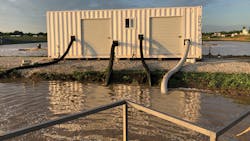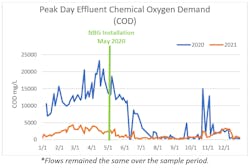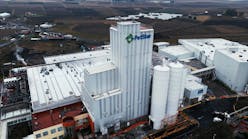Case study: Nanobubbles reduce BOD/COD concentrations in food processor's wastewater lagoon
A food processing facility with a roughly 3-million-gallon wastewater lagoon was overloaded with solids, resulting in high effluent chemical oxygen demand (COD) and biochemical oxygen demand (BOD) concentrations. Using nanobubble technology, the facility was able to reduce effluent COD concentrations and degrade excess sludge that had accumulated in the lagoon.
Wastewater lagoons require oxygen
Using lagoons to treat wastewater is inspired by naturally occurring processes in waterbodies like lakes and ponds that break down and digest waste. These natural processes rely on dissolved oxygen that is transferred by wind blowing across the water and photosynthetic aquatic organisms like algae. For wastewater lagoons that require more dissolved oxygen than nature provides, surface or diffused aerators are used to increase the transfer of oxygen from the atmosphere to the water.
Unless overloaded, wastewater treatment occurs naturally in shallow aerobic lagoons with the help of aerobic bacteria and algae. In aerobic lagoons, organic waste (measured as COD and BOD) is converted to carbon dioxide and water, resulting in effluent water quality that complies with discharge requirements. This process can take anywhere from three to 50 days depending on influent wastewater quality, site conditions and dissolved oxygen levels.
When dissolved oxygen levels are too low, the aerobic processes of a wastewater lagoon are inhibited, resulting in the accumulation of sludge that diminishes treatment capacity and effluent water quality. As sludge levels rise, organic removal rates decrease leading to high effluent COD and BOD concentrations.
Nanobubbles increase aerobic conditions
Two of Moleaer’s 1,000-gallon-per-minute Titan nanobubble generators (NBGs) with an oxygen concentrator were installed on the food processor’s wastewater lagoon with the purpose of reducing effluent COD concentrations.
Natural processes and the existing surface aerators did not provide enough oxygen transfer to meet the biological process demand. For a sustainable, chemical-free solution, the plant looked to Moleaer’s nanobubble technology.
Moleaer’s nanobubble technology has a high gas transfer rate at over 85% transfer efficiency. Nanobubbles do not rise to the surface and pop like larger bubbles, but rather move randomly through the liquid and into the sludge accumulated in a lagoon. By maintaining aerobic conditions at the sludge layer, Moleaer’s technology increases the rate of sludge digestion in a lagoon because aerobic digestion occurs much faster and produces far less odors than anaerobic digestion.
The NBGs were installed in May of 2020. The associated graph shows the effluent COD concentrations for all of 2020, including the six months prior to the installation, and 2021. Immediately after NBG startup, effluent COD concentrations decreased, resulting in more stable effluent concentrations during 2021. Year-over-year peak day effluent COD concentration also shows a significant reduction in COD, from an average of 13,400 mg/L to 2,500 mg/L, an 81% decrease.
Andrea White is director of water process engineering at Moleaer. She has a broad-based knowledge of water and wastewater treatment design, specializing in biological and chemical oxidation processes and gas-to-liquid transfer. In her current role, Andrea leads the application engineering team at Moleaer, where her research focuses on developing the science of nanobubbles and their application within the Water-Environment-Food nexus.




